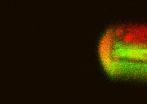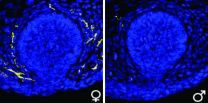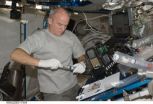(Press-News.org) HOUSTON – (Dec. 7, 2012) – For much of her professional life, Dr. Susan Rosenberg (www.bcm.edu/genetics/?pmid=11034) has studied the puzzling response of bacteria to stress and the mutations that result. In the current issue of the journal Science (www.sciencemag.org), she puts together the pieces of that puzzle, describing most of the members of an elaborate gene network that functions in causing mutations during repair of double-stranded breaks in the DNA of stressed cells.
"We now know the 93 genes more than half of which are funneling into three nodes that go down the mutagenesis pathway," said Rosenberg, professor of molecular and human genetics at Baylor College of Medicine (www.bcm.edu) and 2009 winner of the National Institutes of Health Director's Pioneer Award (https://dcb.nci.nih.gov/Pages/PioneerAwards.aspx).
Rosenberg's groundbreaking work has shown that the rate of mutation can be increased in response to stress such as starvation or environmental challenges such as antibiotics. This changes old ideas about constant and gradual accumulation of mutations over time. Some mutations are detrimental; others can promote survival. In this work, she and her colleagues sought to define the cellular pathways that result in this stress response.
"We screened for every gene in Escherichia coli that is needed to make this happen," said Rosenberg. E. coli is a "model" organism often used in the laboratory to study cells, because its DNA and other components work similarly to those in humans.
They have found that the mutagenic part of the process is not required to repair the broken DNA strands. When they "knock out" or remove the special "error-prone" DNA copying enzyme or polymerase, "the DNA is repaired beautifully and there are no mutations." So, cells do not make mutations because they have to, to repair DNA. Rather, this mechanism appears to regulate production of mutations, making more during stress, when cells are poorly adapted to their environments, and most likely to benefit from mutations.
"Fewer than 16 proteins that are needed to accomplish stress-inducible mutagenesis were known previously. This is about the number known for any molecular mechanism of DNA biology," said Rosenberg. "Our screen sought the whole list of all proteins the cell uses to make it happen."
The painstaking process, begun by then postdoctoral fellow Dr. Mary-Jane Lombardo, now of Seres Health, Inc., in Cambridge, Mass., was completed by Dr. Amar Al Mamun, an assistant professor in Rosenberg's laboratory at BCM.
Large fractions of the network work "upstream" of the activation of the stress response, showing that these proteins apparently "sense" the stress. In delineating how the network functions, Rosenberg and her colleagues identified specific pathways through which the proteins sense the environment and connected them to the molecular mechanism that promotes the mutations.
The findings reveal key factors about the cells, such as that stress-response regulators act as key network hubs, she said. Most of the proteins in the network deal with whether or not the cells feel stress, said Rosenberg.
"The cell devotes a large number of proteins to controlling the process that generates diversity," she said. "And most of them are sensing the environment and coupling mutagenesis to stress."
They have determined the function of about half the network and are working on the rest.
"It's a resounding confirmation of the regulation of mutagenesis by stress responses, which causes mutations specifically when cells are maladapted to their environment—when mutations might allow the cell to adapt," said Rosenberg.
It is also a demonstration that one can hope to detangle large protein networks into specific biological functions. Large protein networks are being discovered in many areas of biology, but what roles the proteins play in particular biological processes is often difficult to determine. Rosenberg's study shows that by working backwards from a defined molecular mechanism, they could assign roles to more than half the network proteins. Rosenberg thinks this strategy will be useful for many other protein networks.
### Others who took part in this work include Dr. Chandan Shee, Dr. Andreas M. Lisewski, Dr. Caleb Gonzalez, Dr. Dongxu Lin, Dr. Ralf B. Nehring, Dr. Janet L Gibson, Dr. Ryan L Frisch, Dr. Olivier Lichtarge and Dr. P. J. Hastings, all of BCM; and Dr. Claude Saint-Ruf of INSERM, France.
Funding for this work came from grants from the National Institutes of Health and National Science Foundation.
Gene network illuminates stress, mutation and adaptation responses
2012-12-07
ELSE PRESS RELEASES FROM THIS DATE:
World's smallest reaction chamber
2012-12-07
Scientists from New Zealand, Austria and the UK have created the world's smallest reaction chamber, with a mixing volume that can be measured in femtolitres (million billionths of a litre).
Using this minuscule reaction chamber, lead researcher Peter Derrick, professor of chemical physics and physical chemistry and head of the Institute of Fundamental Sciences at Massey University in New Zealand, plans to study the kind of speedy, nanoscale biochemical reactions that take place inside individual cells. This work appears in the latest issue of the European Journal of Mass ...
Cognitive behavioural therapy can reduce depression in those haven't responded to antidepressants
2012-12-07
Antidepressants are the most widely used treatment for people with moderate to severe depression. However, up to two thirds of people with depression don't respond fully to this type of treatment. New findings, published in The Lancet, have shown cognitive behavioural therapy (CBT)*, provided in addition to usual care, can reduce symptoms of depression and help improve patients' quality of life.
This is the first large-scale trial to test the effectiveness of CBT — a type of talking psychotherapy — given in addition to usual care that includes antidepressants. The National ...
New genetic disorder of balance and cognition discovered
2012-12-07
The family of disorders known as ataxia can impair speech, balance and coordination, and have varying levels of severity. Scientists from the Universities of Oxford and Edinburgh have identified a new member of this group of conditions which is connected to 'Lincoln ataxia', so called because it was first found in the relatives of US President Abraham Lincoln. The results are published in the journal PLOS Genetics.
Lincoln ataxia affects the cerebellum, a crucial part of the brain controlling movement and balance. It is caused by an alteration in the gene for 'beta-III ...
Women with higher carotenoid levels have reduced risk of breast cancer
2012-12-07
Women with higher circulating carotenoid levels are at a reduced risk of breast cancer according to a study published December 6 in the Journal of the National Cancer Institute
Carotenoids, which are micronutrients found in fruits and vegetables, have been found to have anticarcinogenic properties. Previous experimental studies have shown that carotenoids inhibit the tumor progression and reduce proliferation of estrogen receptor–positive (ER+) and estrogen receptor–negative (ER-) breast cancers. Despite the inverse association between carotenoids and breast cancer ...
His and hers: Male hormones control differences in mammary gland nerve growth
2012-12-07
Johns Hopkins scientists have found a surprising mechanism that gives male sex hormones like testosterone control over the gender-specific absence or presence of mammary gland nerves that sense the amount of milk available in breast milk ducts.
In a Dec. 7 report on their discovery in Science, they say the hormones do the job by altering the availability of a nerve growth factor, called BDNF for short.
The most obvious differences between males and females involve the presence or absence of physical structures. Below the surface, however, these structures are penetrated ...
USC scientists turn a harmful greenhouse gas into a tool for making pharmaceuticals
2012-12-07
A team of chemists at USC has developed a way to transform a hitherto useless ozone-destroying greenhouse gas that is the byproduct of Teflon manufacture and transform it into reagents for producing pharmaceuticals.
The team will publish their discovery in a paper entitled "Taming of Fluoroform (CF3H): Direct Nucleophilic Trifluoromethylation of Si, B, S and C Centers," in the Dec. 7 issue of Science.
The method is also being patented.
Because of the popularity of Teflon, which is used on everything from cooking pans to armor-piercing bullets, there's no shortage ...
New research investigates how the common 'cat parasite' gets into the brain
2012-12-07
A new study demonstrates for the first time how the Toxoplasma gondii parasite enters the brain to influence its host's behavior. This research was led by researchers from the Karolinska Institute and Uppsala University in Sweden publishes today in the Open Access journal PLOS Pathogens.
The Toxoplasma gondii parasite causes toxoplasmosis. The parasite is common and infects between 30 and 50 per cent of the global population. It also infects animals, especially domestic cats. Human infection is contracted by eating poorly cooked (infected) meat and handling cat feces. ...
Vaginal microbicide gel may offer a promising strategy for prevention and protection against HIV transmission
2012-12-07
A new study shows that a microbicide gel is highly effective in block infection by the AIDS virus in a non-human primate model. In the paper published December 6 in the Open Access journal PLOS Pathogens, Dereuddre-Bosquet and colleagues from the European Combined Highly Active Anti-Retroviral Microbicides (CHAARM) Consortium describe the gel's key ingredient, which are small peptides engineered to present a decoy to bind up the virus and prevent it from entering and infecting the cells of the body. Because this is a gel it can be topically applied and could represent ...
What happens to plant growth when you remove gravity?
2012-12-07
It is well known that plant growth patterns are influenced by a variety of stimuli, gravity being one amongst many. On Earth plant roots exhibit characteristic behaviours called 'waving' and 'skewing', which were thought to be gravity-dependent events. However, Arabidopsis plants grown on the International Space Station (ISS) have proved this theory wrong, according to a study published in BioMed Central's open access journal BMC Plant Biology: root 'waving' and 'skewing' occur in spaceflight plants independently of gravity.
In plant roots, 'waving' consists of a series ...
Lenalidomide offers an effective alternative treatment for cutaneus lupus erythematosus
2012-12-07
Although rare there are several treatments available for cutaneus lupus erythematosus (CLE). However other options are needed for people who do not respond to medication or relapse. A new study into the thalidomide derivative lenalidomide, published today in BioMed Central's open access journal Arthritis Research & Therapy, shows that treatment with lenalidomide is safe, with patients seeing an improvement in as little as two weeks.
There have been several small scale clinical studies into the use of thalidomide for CLE for the third of patients which do not respond to ...


